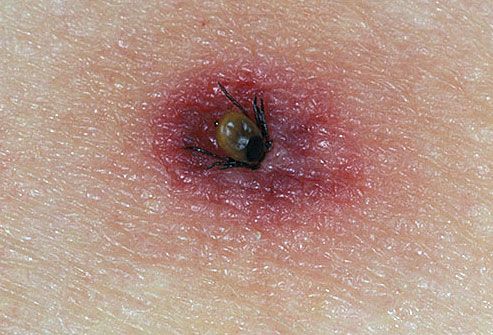The Advance of Ticks: New Areas, New Diseases, and a Weird Allergy to Meat
By Maryn McKenna at wyred.com
Following up on last week’s post about the advance of dengue: I’ve been keeping track of new news regarding other diseases transmitted by insects and arthropods, but haven’t had a chance to write them up. So here’s an end-of-year round-up. It’s not cheery (are my posts ever cheery?), but maybe it will prompt some New Year’s resolutions to wear repellents and long pants outdoors. These diseases are no fun.
The big player in tickborne illnesses is Lyme disease, and one of the most disputed issues within that condition is whether the infection can linger in a chronic form after treatment with antibiotics, and cause long-lasting symptoms. (This is separate from the problem of an unrecognized Lyme infection never being diagnosed or treated.) In one study in 2003, 10 percent of patients who got the standard treatment for Lyme still showed symptoms more than a year afterward; 4 percent showed symptoms at every follow-up visit; and 15 percent had a recurrence of the distinctive “bull’s eye” rash that is a diagnostic signal for Lyme. The team who did that 2003 study decided to look further into those recurrences, and their results were published in the New England Journal of Medicine last month.
They chose a small group (17 patients) who experienced rash recurrences at least a year, and sometimes many years, apart, and analyzed Lyme bacteria isolated from their skin or blood during each episode. (The patients were enrolled in ongoing studies at New York Medical College, so years-earlier samples were available.) They analyzed a particular protein (outer-surface protein C, or ospC) that is expressed soon after infection takes place, and found that for any of the patients, the proteins were slightly different. Based on this, the researchers conclude that the patients they studied were not suffering from long-lasting infections and relapsing; instead, they were undergoing new infections — which happened to occur in the same time of year, and often on the same body part, as the original infection a year or more before.
At about the same time that paper was published, researchers attending the annual meeting of the American Society of Tropical Medicine and Hygiene in Atlanta were also discussing the spread of Lyme disease, along with the advance of less well-known tickborne illnesses.
In one presentation, researchers from the Yale schools of medicine and public health reported on the interplay between Lyme and the emerging illness babesiosis, which is also transmitted by ticks, and which spends part of its life cycle in the same rodent, the white-footed mouse. They found that when rodents are infected with both organisms (the Lyme disease bacterium Borrelia burgdorferei and the babesiosis parasite Babesia microti), the levels of Babesia rise higher in the mice’s blood than if they were infected only with babesiosis, and as a result the mice are more likely to transmit Babesia back to tick larvae. In other words, the Lyme bacterium somehow seemed to be intensifying babesiosis transmission.
That finding may explain, in part, why babesiosis is emerging so quickly, because the areas where the two diseases are common overlap. Another presentation by Yale researchers (this time with co-authors from Tufts University, the Connecticut Department of Public Health, and several private medical practices) described babesiosis’ rapid rise: In 2000, cases were reported in 30 towns in Connecticut; by 2008, it was in 85 towns. At least 10 percent of ticks caught in northern Connecticut now carry the parasite, a rate as high as Nantucket, where babesiosis was first spotted and dubbed “Nantucket fever” decades ago.
Because Lyme and babesiosis are northeastern diseases, the other tickborne illnesses in the United States tend to not get much attention. Researchers from the CDC, University of North Carolina and North Carolina State University who also attended ASTMH said that lack of awareness is causing some under-appreciated risks. Forest, parks and wildlife workers in North Carolina were scheduled to take part in a trial of clothing impregnated with tick repellent — but to give the study a baseline, they agreed to be tested for evidence of prior tickborne-illness infection. To everyone’s surprise, almost one-quarter of the workers showed serologic evidence that they had already been infected with at least one of several tick-transmitted organisms. (The organisms were Rickettsia parkeri, Rickettsia rickettsii and Rickettsia amblyommii.).
In that study, the outdoor workers also submitted for study any ticks that bit them. The vast majority were the lone star tick (Amblyomma americanum), which is common in the Southeastern US; its range is increasing, which is troubling because that tick transmits a different illness, “Southern tick-associated rash illness” or STARI. (Despite the name, STARI infections have now been found as far north as New York.) But, it turns out, infections carried by that tick are not the only concern — and this last item is probably the strangest tick-related story of the bunch.
In a presentation at a different scientific meeting happening at the same time as ASTMH — the ACAAI, or American College of Allergy, Asthma and Immunology — researchers revealed that the bite of a lone star tick can induce antibodies to a sugar, galactose-alpha-1,3-galactose or alpha gal for short. The problem: That sugar is present in most red meat — beef, pork, and lamb — and also in products made from meat, including gelatin. Once that antibody has been created, the result is a serious, and rapidly worsening — in fact, potentially life-threatening — allergy to meat and meat products.
So, to sum up: The geographic ranges of different tick species are expanding. Diseases caused by ticks are becoming more common, and they are serious. People don’t understand the ways in which they might be at risk. And if you don’t take them seriously, and you get bitten by the wrong tick, you might have to give up meat for life. So on that resolutions list: maybe some socks and DEET?